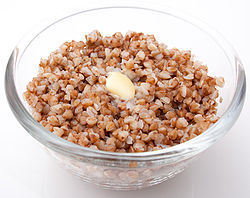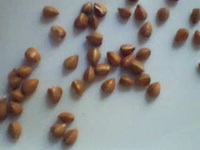Kasha
 Buckwheat kasha | |
| Type | Porridge, oatmeal |
|---|---|
| Region or state | Eastern Europe |
| Main ingredients | Cereal (buckwheat, wheat, barley, oats, millet or rye) |
In English, kasha usually[a][b][c] refers to the pseudocereal buckwheat or its culinary preparations. In Eastern European cuisine, kasha can apply to any kind of cooked grain. It can be baked but most often is boiled, either in water or milk, and therefore the term coincides with the English definition of 'porridge', but the word can also refer to the grain before preparation, which corresponds to the definition of 'groats'. Kasha is eaten widely in Belarus (каша), the Czech Republic (kaše), Lithuania (košė), Poland (kasza), Romania and Moldova (cașa), Russia (каша), Slovakia (kaša), Slovenia (kaša), Kazakhstan, and Ukraine (каша), where the term, besides buckwheat, can apply to wheat, barley, oats, millet, rye and even rice. Kasha has been an important element of Slavic diet for at least 1,000 years.[1]
This English-language usage probably originated with Jewish immigrants, as did the form קאַשי kashi (literally translated as "porridges").[2]
-
Buckwheat with onions
In Ashkenazi Jewish culture
[edit]As an Ashkenazi-Jewish comfort food, kasha is often served with onions and brown gravy on top of farfalle, known as kasha varnishkes.[3] Kasha is a popular filling for knishes[4] and is sometimes included in matzah-ball soup.[citation needed]
In Czechia
[edit]In Czech the cognate kaše (Czech pronunciation: [kaʃɛ]) has a wider meaning that also encompasses mashed potato (bramborová kaše), pease pudding (hrachová kaše), etc.
In Poland
[edit]
In Polish, cooked buckwheat groats are referred to as kasza gryczana. Kasza can apply to many kinds of groats: millet (kasza jaglana), barley (kasza jęczmienna), pearl barley (kasza jęczmienna perłowa, pęczak), oats (kasza owsiana), as well as porridge made from farina (kasza manna).[5] Bulgur can be also be referred to as a type of kasza in Polish (kasza bulgur).
As Polish blood sausage is prepared with buckwheat, barley or rice, it is called kaszanka (kasha sausage).
Annual per capita consumption of groats in Poland was approximately 1.56 kg (3.4 lb) per year in 2013.[6]
In Russia
[edit]
The largest gross buckwheat consumption per capita is in Russia, with 15 kg (33 lb) per year, followed by Ukraine, with 12 kg (26 lb) per year.[7] Buckweat comprises 20% of all cereal consumption in Russia.[8]
In Russian, buckwheat is referred to formally as гречиха (grechi(k)ha), or colloquially as гречка (grechka). Buckwheat grain and buckwheat groats are known as гречневая крупа (grechnevaya krupa). Corresponding words in Yiddish are gretshkes/greytshkelach and retshkes/reytshkelach.
The most popular kasha recipe in Russia is that of crumbly cooked buckwheat seasoned with butter. Buckwheat kasha can be eaten at any time of the day, either as a separate dish or as a side dish. Other popular kasha recipes are made with millet, semolina (манная каша) and oatmeal. Cooked with milk and sugar, they are often seen as a breakfast staple, especially for children. Pearl barley porridge is less popular but also eaten. High quality tushonka can be used to season kasha as well, since tushonka is rich in flavor and full gravy-like jelly, but the jelly needs some heating to melt into kasha.
Kasha is one of the Russian national dishes, together with shchi. This fact is commemorated in the Russian saying, "щи да каша – пища наша" (shchi da kasha – pishcha nasha), which literally translates as "shchi and kasha are our food" or "cabbage soup and porridge are what we eat". The expression has an implied figurative meaning of "it is enough to eat those two meals to live" or "it doesn't matter what happens in Russia at large, we still live the same way."
Butter is often eaten with most kasha recipes, hence another Russian saying: "кашу маслом не испортишь", which translates to "you won't ruin kasha with butter".[9]
See also
[edit]Notes
[edit]- ^ Merriam-Webster's Dictionary definition: a porridge made usually from buckwheat groats, "Merriam-Webster's Dictionary". Retrieved 21 May 2020.
- ^ Oxford Dictionary definition: (in Russia and Poland) porridge made from cooked buckwheat or similar grain., "Lexico". Archived from the original on August 29, 2021. Retrieved 21 May 2020.
- ^ Collins Dictionary definition: dish originating in Eastern Europe, consisting of boiled or baked buckwheat, "Collins English Dictionary". Retrieved 21 May 2020.
References
[edit]- ^ Molokhovets, Elena (1998). Classic Russian Cooking. Indiana University Press. p. 331.
- ^ Steinmetz, Sol. Dictionary of Jewish Usage: A Guide to the Use of Jewish Terms. p. 42. ISBN 0-7425-4387-0.
- ^ "Le Cordon Jew". May 22, 2008. Archived from the original on 2015-03-25. Retrieved 2011-01-15.
- ^ "Archived copy". Archived from the original on 2007-04-21. Retrieved 2007-05-22.
{{cite web}}: CS1 maint: archived copy as title (link). Retrieved May 30, 2007. - ^ "Polish Food 101 ‒ Groats". Culture.pl. 9 April 2015. Retrieved 21 May 2020.
- ^ Biuletyn Informacyjny ARR 4/2013, Handel Wewnętrzny 4/2013 IBRKK
- ^ No 8 [008] 26 жовтня, 2007; [www.agro-business.com.ua/.../1655-2013-06-25-11]
- ^ Russian Market of Buckwheat in 2009 - September 2010 Archived 2016-03-03 at the Wayback Machine
- ^ "Nourish Your Language: Foodie Words Refashioned". Archived from the original on 2016-11-15. Retrieved 2017-01-31.
External links
[edit] Media related to Buckwheat groats at Wikimedia Commons
Media related to Buckwheat groats at Wikimedia Commons The dictionary definition of kasha at Wiktionary
The dictionary definition of kasha at Wiktionary


